香港中文大学:《Probability and Statistics for Engineers》课程教学资源(辅导材料)Tutorial 1:Sample Space and Probability 1
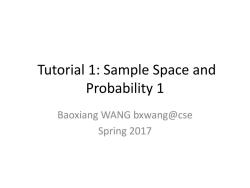
Tutorial 1:Sample Space and Probability 1 Baoxiang WANG bxwang@cse Spring 2017
Tutorial 1: Sample Space and Probability 1 Baoxiang WANG bxwang@cse Spring 2017

Probability models A probability model is an assignment of probabilities to every element of the sample space. Probabilities are nonnegative and add up to one. Examples S=HH,HT,TH,TT /44/4/4 107 models a pair of coins with equally likely outcomes
Probability models A probability model is an assignment of probabilities to every element of the sample space. Probabilities are nonnegative and add up to one. S = { HH, HT, TH, TT } ¼ ¼ ¼ ¼ Examples models a pair of coins with equally likely outcomes
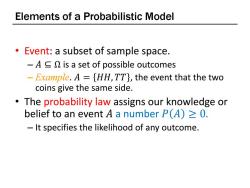
Elements of a Probabilistic Model Event:a subset of sample space. -A is a set of possible outcomes -Example.A ={HH,T'T},the event that the two coins give the same side. The probability law assigns our knowledge or belief to an event Aa number P(A)0. It specifies the likelihood of any outcome
Elements of a Probabilistic Model • Event: a subset of sample space. – 𝐴 ⊆ Ω is a set of possible outcomes – Example. 𝐴 = 𝐻𝐻, 𝑇𝑇 , the event that the two coins give the same side. • The probability law assigns our knowledge or belief to an event 𝐴 a number 𝑃 𝐴 ≥ 0. – It specifies the likelihood of any outcome

Probability Axioms 1.(Won-negativity)P(A)≥0,for every event A. 2.(Additivity)For any two disjoint events A and B,P(AUB)=P(A)+P(B) In general,if A1,A2,..are disjoint events, then P(A1UA2U…)=P(A1)+P(A2)+… 3.(Normalization)P()=1
Probability Axioms 1. (Non-negativity) 𝑃(𝐴) ≥ 0, for every event 𝐴. 2. (Additivity) For any two disjoint events 𝐴 and 𝐵, 𝑃 𝐴 ∪ 𝐵 = 𝑃 𝐴 + 𝑃 𝐵 In general, if 𝐴1, 𝐴2, … are disjoint events, then 𝑃 𝐴1 ∪ 𝐴2 ∪ ⋯ = 𝑃 𝐴1 + 𝑃 𝐴2 + ⋯ 3. (Normalization) 𝑃(Ω) = 1

Question If 4 boys and 4 girls randomly sit in a row,what is the probability of the following seating arrangement (a)the boys and the girls are each to sit together The total number of all arrangements is 81=40320 The number of target arrangements is 4!×4!×2=1152 The probability #target arrangements] 11521 #all arrangements) 40320 35
Question If 4 boys and 4 girls randomly sit in a row, what is the probability of the following seating arrangement (a) the boys and the girls are each to sit together The total number of all arrangements is 8!=40320 The number of target arrangements is 4! ×4! ×2=1152 The probability #{𝑡𝑎𝑟𝑔𝑒𝑡 𝑎𝑟𝑟𝑎𝑛𝑔𝑒𝑚𝑒𝑛𝑡𝑠} #{𝑎𝑙𝑙 𝑎𝑟𝑟𝑎𝑛𝑔𝑒𝑚𝑒𝑛𝑡𝑠} = 1152 40320 = 1 35
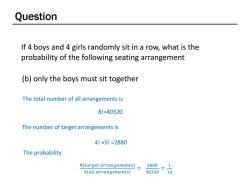
Question If 4 boys and 4 girls randomly sit in a row,what is the probability of the following seating arrangement (b)only the boys must sit together The total number of all arrangements is 81=40320 The number of target arrangements is 4!×5!=2880 The probability #{target arrangements} = 28801 #all arrangements) 40320 14
Question If 4 boys and 4 girls randomly sit in a row, what is the probability of the following seating arrangement (b) only the boys must sit together The total number of all arrangements is 8!=40320 The number of target arrangements is 4! ×5! =2880 The probability #{𝑡𝑎𝑟𝑔𝑒𝑡 𝑎𝑟𝑟𝑎𝑛𝑔𝑒𝑚𝑒𝑛𝑡𝑠} #{𝑎𝑙𝑙 𝑎𝑟𝑟𝑎𝑛𝑔𝑒𝑚𝑒𝑛𝑡𝑠} = 2880 40320 = 1 14
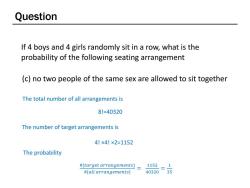
Question If 4 boys and 4 girls randomly sit in a row,what is the probability of the following seating arrangement (c)no two people of the same sex are allowed to sit together The total number of all arrangements is 81=40320 The number of target arrangements is 4!×4!×2=1152 The probability #target arrangements] 11521 #all arrangements) 40320 35
Question If 4 boys and 4 girls randomly sit in a row, what is the probability of the following seating arrangement (c) no two people of the same sex are allowed to sit together The total number of all arrangements is 8!=40320 The number of target arrangements is 4! ×4! ×2=1152 The probability #{𝑡𝑎𝑟𝑔𝑒𝑡 𝑎𝑟𝑟𝑎𝑛𝑔𝑒𝑚𝑒𝑛𝑡𝑠} #{𝑎𝑙𝑙 𝑎𝑟𝑟𝑎𝑛𝑔𝑒𝑚𝑒𝑛𝑡𝑠} = 1152 40320 = 1 35
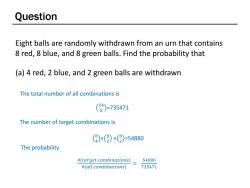
Question Eight balls are randomly withdrawn from an urn that contains 8 red,8 blue,and 8 green balls.Find the probability that (a)4 red,2 blue,and 2 green balls are withdrawn The total number of all combinations is ()=735471 The number of target combinations is (8)×()×()=54880 The probability #(target combinations) 54880 #fall combinations} 735471
Question Eight balls are randomly withdrawn from an urn that contains 8 red, 8 blue, and 8 green balls. Find the probability that (a) 4 red, 2 blue, and 2 green balls are withdrawn The total number of all combinations is 24 8 =735471 The number of target combinations is 8 4 × 8 2 × 8 2 =54880 The probability #{𝑡𝑎𝑟𝑔𝑒𝑡 𝑐𝑜𝑚𝑏𝑖𝑛𝑎𝑡𝑖𝑜𝑛𝑠} #{𝑎𝑙𝑙 𝑐𝑜𝑚𝑏𝑖𝑛𝑎𝑡𝑖𝑜𝑛𝑠} = 54880 735471

Question Eight balls are randomly withdrawn from an urn that contains 8 red,8 blue,and 8 green balls.Find the probability that (b)at least 3 red balls are withdrawn The total number of all combinations is ()=735471 The number of target combinations is (4)-()x()-()×(,)-(s)=406857 The probability #(target combinations) 12329 #fall combinations} 22287
Question Eight balls are randomly withdrawn from an urn that contains 8 red, 8 blue, and 8 green balls. Find the probability that (b) at least 3 red balls are withdrawn The total number of all combinations is 24 8 =735471 The number of target combinations is 24 8 − 8 2 × 16 6 − 8 1 × 16 7 − 16 8 =406857 The probability #{𝑡𝑎𝑟𝑔𝑒𝑡 𝑐𝑜𝑚𝑏𝑖𝑛𝑎𝑡𝑖𝑜𝑛𝑠} #{𝑎𝑙𝑙 𝑐𝑜𝑚𝑏𝑖𝑛𝑎𝑡𝑖𝑜𝑛𝑠} = 12329 22287
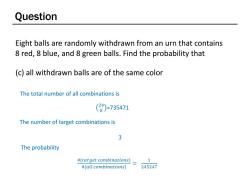
Question Eight balls are randomly withdrawn from an urn that contains 8 red,8 blue,and 8 green balls.Find the probability that (c)all withdrawn balls are of the same color The total number of all combinations is ()=735471 The number of target combinations is 3 The probability #(target combinations) 1 #fall combinations} 245247
Question Eight balls are randomly withdrawn from an urn that contains 8 red, 8 blue, and 8 green balls. Find the probability that (c) all withdrawn balls are of the same color The total number of all combinations is 24 8 =735471 The number of target combinations is 3 The probability #{𝑡𝑎𝑟𝑔𝑒𝑡 𝑐𝑜𝑚𝑏𝑖𝑛𝑎𝑡𝑖𝑜𝑛𝑠} #{𝑎𝑙𝑙 𝑐𝑜𝑚𝑏𝑖𝑛𝑎𝑡𝑖𝑜𝑛𝑠} = 1 245247
按次数下载不扣除下载券;
注册用户24小时内重复下载只扣除一次;
顺序:VIP每日次数-->可用次数-->下载券;
- 香港中文大学:《Probability and Statistics for Engineers》课程教学资源(课件讲稿)Classical Statistical Inference.pptx
- 香港中文大学:《Probability and Statistics for Engineers》课程教学资源(课件讲稿)General random variables.pptx
- 香港中文大学:《Probability and Statistics for Engineers》课程教学资源(课件讲稿)Classical Statistical Inference.pdf
- 香港中文大学:《Probability and Statistics for Engineers》课程教学资源(课件讲稿)Bayesian Statistical Inference.pptx
- 香港中文大学:《Probability and Statistics for Engineers》课程教学资源(课件讲稿)Bayesian Statistical Inference.pdf
- 香港中文大学:《Probability and Statistics for Engineers》课程教学资源(课件讲稿)Limit Theorems.pptx
- 香港中文大学:《Probability and Statistics for Engineers》课程教学资源(课件讲稿)Limit Theorems.pdf
- 香港中文大学:《Probability and Statistics for Engineers》课程教学资源(课件讲稿)General random variables.pdf
- 香港中文大学:《Probability and Statistics for Engineers》课程教学资源(课件讲稿)Further Topics on Random Variables.pptx
- 香港中文大学:《Probability and Statistics for Engineers》课程教学资源(课件讲稿)Further Topics on Random Variables.pdf
- 香港中文大学:《Probability and Statistics for Engineers》课程教学资源(课件讲稿)Discrete random variables.pptx
- 香港中文大学:《Probability and Statistics for Engineers》课程教学资源(课件讲稿)Discrete random variables.pdf
- 香港中文大学:《Probability and Statistics for Engineers》课程教学资源(课件讲稿)Sample space and probability.pptx
- 香港中文大学:《Probability and Statistics for Engineers》课程教学资源(课件讲稿)Sample space and probability.pdf
- 香港中文大学:Random Walk on Graphs and its Algorithmic Applications.ppt
- 香港中文大学:An Introduction to Quantum Computing in Theoretical Computer Science.ppt
- 香港中文大学:On the power of lower bound methods for quantum one-way communication complexity.ppt
- 香港中文大学:Quantum strategic game theory.ppt
- 香港中文大学:A quantum protocol for sampling correlated equilibria unconditionally and without a mediator.pptx
- 香港中文大学:On the complexity of trial and error.pptx
- 香港中文大学:《Probability and Statistics for Engineers》课程教学资源(辅导材料)Tutorial 1:Sample Space and Probability 1.pptx
- 香港中文大学:《Probability and Statistics for Engineers》课程教学资源(辅导材料)Tutorial 2:Sample Space and Probability 2.pdf
- 香港中文大学:《Probability and Statistics for Engineers》课程教学资源(辅导材料)Tutorial 2:Sample Space and Probability 2.pptx
- 香港中文大学:《Probability and Statistics for Engineers》课程教学资源(辅导材料)Tutorial 3:Discrete Random Variables 1.pdf
- 香港中文大学:《Probability and Statistics for Engineers》课程教学资源(辅导材料)Tutorial 3:Discrete Random Variables 1.pptx
- 香港中文大学:《Probability and Statistics for Engineers》课程教学资源(辅导材料)Tutorial 4:Discrete Random Variables 2.pdf
- 香港中文大学:《Probability and Statistics for Engineers》课程教学资源(辅导材料)Tutorial 4:Discrete Random Variables 2.pptx
- 香港中文大学:《Probability and Statistics for Engineers》课程教学资源(辅导材料)Tutorial 5:General Random Variables 1.pdf
- 香港中文大学:《Probability and Statistics for Engineers》课程教学资源(辅导材料)Tutorial 5:General Random Variables 1.pptx
- 香港中文大学:《Probability and Statistics for Engineers》课程教学资源(辅导材料)Tutorial 6:General Random Variables 2.pdf
- 香港中文大学:《Probability and Statistics for Engineers》课程教学资源(辅导材料)Tutorial 6:General Random Variables 2.pptx
- 香港中文大学:《Probability and Statistics for Engineers》课程教学资源(辅导材料)Tutorial 7:General Random Variables 3.pdf
- 香港中文大学:《Probability and Statistics for Engineers》课程教学资源(辅导材料)Tutorial 7:General Random Variables 3.pptx
- 香港中文大学:《Probability and Statistics for Engineers》课程教学资源(辅导材料)Tutorial 10:Limit Theorems.pdf
- 香港中文大学:《Probability and Statistics for Engineers》课程教学资源(辅导材料)Tutorial 10:Limit Theorems.pptx
- 香港中文大学:《Probability and Statistics for Engineers》课程教学资源(辅导材料)Tutorial 8:Further Topics on Random Variables 1.pdf
- 香港中文大学:《Probability and Statistics for Engineers》课程教学资源(辅导材料)Tutorial 11:Limit Theorems.pdf
- 香港中文大学:《Probability and Statistics for Engineers》课程教学资源(辅导材料)Tutorial 9:Further Topics on Random Variables 2.pptx
- 香港中文大学:《Probability and Statistics for Engineers》课程教学资源(辅导材料)Tutorial 11:Limit Theorems.pptx
- 香港中文大学:《Probability and Statistics for Engineers》课程教学资源(辅导材料)Tutorial 9:Further Topics on Random Variables 2.pdf
